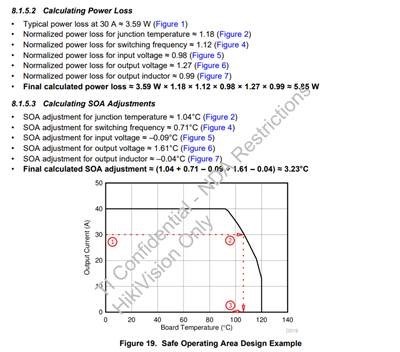Hi team,
My customer is using our CSD95496, and they find this waveform in the datasheet:

Could you please kindly help explain how to understand this SOA Temperature Adj?
We can't find much explanation from the datasheet.
Thanks,
Brian
This thread has been locked.
If you have a related question, please click the "Ask a related question" button in the top right corner. The newly created question will be automatically linked to this question.
Hi team,
My customer is using our CSD95496, and they find this waveform in the datasheet:

Could you please kindly help explain how to understand this SOA Temperature Adj?
We can't find much explanation from the datasheet.
Thanks,
Brian
Hi
Hope these materials help you.
Regards
Yihe
Hello,
The normalized power loss is Ploss(25C)/Ploss(Tc). At 75C the power loss is 10% higher than 25C.
The SOA Temperature Adj is 0 at 25C. I think it is a coefficient. At 75C, it is 0.6 so 0.6*(75C - 25C) = 30C. It could at 1.1*Ploss(25), the case temperature should be less than 30C.
I will make sure and let you know.
Regards
Hi Mahmoud,
Thanks a lot.
And customer still have a calculate problem as below:
According to the curve, when it is 16A, efficiency use 94% to calculate, Vin is 12V, Vout is 1V, chip loss is 1.13W.
But when calculate as 8.1.5.2,Typical power loss 16A=1.3W
For junction temperature 1.08W
For switch frequence 1.15W
For input voltage 1W
For output voltage 0.95W
For out inductor 1W
Final power loss=1.3*1.15*1*0.95*1*1.08=1.5337W
Could you please kindly help explain why the final power loss will need the other loss to do multiplication?
And why the result is not the same as the efficiency curve?


Also, they still have two other questions:
2、How to understand the minus temperature in the 8.1.5.3 SOA curve?
3、Which one is used to calculate the junction loss?

Thanks,
Brian
Hi Brian,
The example in 8.1.5.1 explains the power loss and the SOA adjustment. I believe simply follow the rules according to the example. The power loss factors are multiplied, and the SOA are added.
Figure 19 shows the board temperature verses current, so the junction temperature is based on junction-to-board thermal resistance.
In your example at 16A, only the output voltage changes. all factors should be 1 except 0.95 for output voltage.
Regards